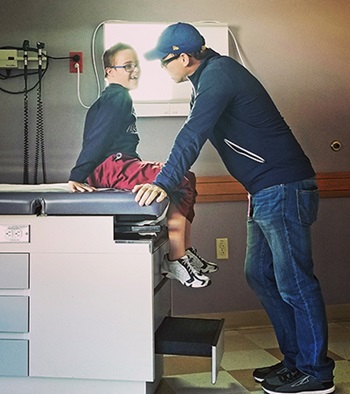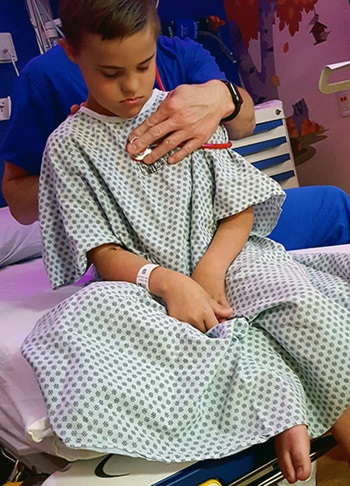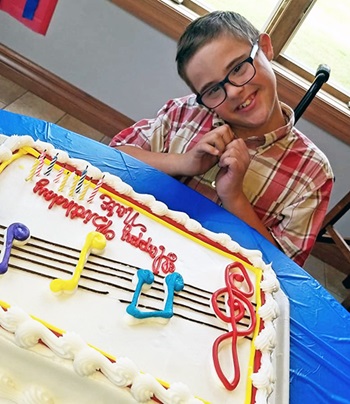Jill Kocian will never forget the shock of panic that ripped through her as she saw her 10-year-old son, Nate, disappear under the water’s surface.
It was a beautiful late summer day in 2017 and Nate was at his family’s cabin in northern Wisconsin. He and his big sister, Maddie, were swimming in the pool while Jill was relaxing in a chair nearby. As Nate floated around aimlessly, clinging to a pool noodle, Maddie swam over to the water’s edge to talk with her mom.
Suddenly, Nate let go of the noodle and sank. But before Jill could even finish getting the words out to alert her daughter, Nate popped back up, a huge smile on his face.
Maddie looked at her mom, confused, and said, “He’s fine!”
“I was shocked,” said Jill. “I didn’t know he could do that.”
Nate was born with spinal muscular atrophy (SMA), a genetic neuromuscular disorder that causes a loss of muscle strength and control. He loved the water. The sensation of weightlessness freed him from the physical limitations of SMA. But until that day, he had always required assistance from floaties or a guardian. He could kick his legs, but just barely, and not enough to keep him afloat.
So, why the sudden change?
Just a few weeks earlier, Nate was one of the first kids in Wisconsin to receive a new, groundbreaking SMA treatment called Spinraza.
Diagnosing SMA
 Nate was born on October 20, 2007. Shortly thereafter he was diagnosed with Down syndrome. Because kids with Down syndrome typically have lower muscle tone, as Nate grew up and experienced movement delays, doctors didn’t think much of it.
Nate was born on October 20, 2007. Shortly thereafter he was diagnosed with Down syndrome. Because kids with Down syndrome typically have lower muscle tone, as Nate grew up and experienced movement delays, doctors didn’t think much of it.
“I have to say, I knew in the back of my head his delays weren’t related to Down syndrome,” said Jill. “I could just tell by the way he was standing and trying to walk that it wasn’t because he had low muscle tone. There was something else happening.”
When Nate was 6 years old, after years of teachers and doctors telling Jill how close he was to walking — just any day now, they’d all say — Jill finally listened to her mother’s intuition and took him to Children’s Wisconsin for testing.
Doctors tested Nate for a variety of ailments — muscular dystrophy, leukemia — and everything kept coming back normal. Finally they did a blood test for SMA. It was positive.
SMA is rare, occurring in about one in every 11,000 births, and is caused by a mutation to the survival motor neuron 1 (SMN1) gene. When this happens, the gene doesn’t produce enough SMN protein. Without this protein, the motor neurons in the spinal cord that transfer signals between the brain and the body’s muscles deteriorate.
“Nate uses a wheelchair and is unable to bear any weight,” said James, Nate’s dad. “Because of this, he needs help with everything — from using the bathroom to getting around in life.”
There are four different types of SMA, based on the child’s ability and age of diagnosis. Type 1 are typically classified as babies who are unable to sit up. Type 2 are toddlers who have never been able to walk. Type 3 (Nate’s type) are older kids who can walk but will lose the ability to do so. Type 4 are typically teens who can walk but have weakness.
Groundbreaking treatment
 Nate’s diagnosis came in the summer of 2012. At that time, there was no treatment for SMA. It was simply a matter of staying on top of his annual wellness visits and making sure he was otherwise healthy.
Nate’s diagnosis came in the summer of 2012. At that time, there was no treatment for SMA. It was simply a matter of staying on top of his annual wellness visits and making sure he was otherwise healthy.
“Before Spinraza, everything was supportive care,” said Matthew Harmelink, MD, pediatric neurologist at Children’s Wisconsin. “Breathing assistance for kids with respiratory failure, braces, wheel chairs or power wheel chairs for kids with progressive motor weakness. You addressed the symptoms as best you could but that was the extent of it.”
At the time of Nate’s diagnosis, Jill and James recall a doctor telling them about Spinraza. Results were promising, they were told, but it was still in the testing phase and not yet FDA approved. They added Nate’s name to the list and for the next four years, they just went on with life.
Finally, in December 2016, Jill and James got word that Spinraza had finally received FDA approval. Jill immediately called Children’s Wisconsin. After a few months of insurance wrangling and training for the hospital staff, on August 9, 2017, Nate became one of the first kids in Wisconsin to receive Spinraza.
“Just one week after his first dose of Spinraza, we began to notice little things — like an ability to straighten himself, stand for longer periods of time and lift his legs like he had never done before,” said Jill.
Spinraza works by targeting and strengthening the SMN2 gene (sort of a backup to the SMN1 gene affected by SMA). This increases SMN protein production and can offset the progression of SMA. It’s important to note that Spinraza doesn’t “cure” SMA, but rather by enhancing the SMN2 gene, it’s able to alleviate the symptoms.
Spinraza is injected directly into the fluid surrounding the spinal cord. There are two treatment phases: a loading dose of four injections over two months which is followed by a maintenance dose every four months. The whole injection process takes maybe 15 minutes total.
“Given his disease, he should be getting weaker. But actually, the reverse is true. He’s getting stronger,” said Jill. “The Spinraza has kept him stable and able to do the things he’s always been able to do, even though he keeps getting bigger and adding more weight on his frame. He hasn’t lost any ability to do anything.”
 Because of the progressive nature of the disease, over time the symptoms become more severe. When it comes to diagnosis and treatment, time is very much of the essence. Children’s Wisconsin is committed to getting these patients in as quickly as possible.
Because of the progressive nature of the disease, over time the symptoms become more severe. When it comes to diagnosis and treatment, time is very much of the essence. Children’s Wisconsin is committed to getting these patients in as quickly as possible.
The Neurosciences Center has a special hypotonia clinic for kids with low muscle tone that is designed to deliver a rapid diagnosis for kids with neuromuscular disorders such as SMA. They’ve also set up a triage process so that when an outside provider calls about a patient suspected of having SMA, the child gets transferred and evaluated as quickly as possible.
Additionally, Children’s Wisconsin is currently collaborating with Wisconsin’s Newborn Screening Lab and UW-Madison to add a SMA test to the standard newborn screening. This test was approved by the Wisconsin’s Scientific Advisory Board in January 2018 and is currently going through the 18-24 month regulatory process.
“We know the sooner we diagnose and treat kids with SMA, the less severe their symptoms will be long term,” said Dr. Harmelink. “The hope is if we capture patients before they clinically have symptoms then they will have the best outcome possible.”
Despite his relatively late diagnosis, Nate, now 11 and more than a year into the Spinraza treatment, continues to make progress. And now when Jill and James look to Nate’s future, where they once saw uncertainty, they now see renewed hope.







